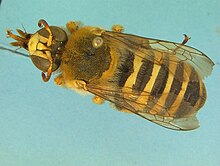Meganomiinae
| Meganomiinae | |
|---|---|

| |
| Meganomia gigas | |
| Scientific classification | |
| Domain: | Eukaryota |
| Kingdom: | Animalia |
| Phylum: | Arthropoda |
| Class: | Insecta |
| Order: | Hymenoptera |
| Clade: | Anthophila |
| Family: | Melittidae |
| Subfamily: | Meganomiinae |
| Genera | |
Meganomiinae is a subfamily of melittid bees, with 10 species in four genera, found only in Africa, primarily in xeric habitats, with the distributional limits in Yemen and Madagascar.[1] They are rather different in appearance from the other groups of past/present melittids, being large bees (10–22 mm), mostly black with strong yellow markings, resembling anthidiine megachilids.[1] Males of this subfamily are known to have hidden sterna.[2]
Taxonomy[edit]
Initial molecular work suggested that the family Melittidae was paraphyletic, and that its subfamilies (including Meganomiinae) should therefore be elevated to family status.[3][4] However, these studies included very few melittids, due to their rarity. A 2013 investigation included a greater number of melittid bees and concluded that the family was probably monophyletic, thus supporting Meganomiinae as a subfamily of Melittidae.[5]
References[edit]
- ^ a b Michez, Denis (2008). "Monographic revision of the melittid bees (Hymenoptera, Apoidea, Melittidae sensu lato)" (PDF). Proceedings of the Netherlands Entomological Society Meeting. 19: 32.
- ^ Michez, D.; Eardley, C.D.; Timmermann, K.; Danforth, B.N. (2010). "Unexpected polylecty in the bee genus Meganomia (Hymenoptera: Apoidea; Melittidae)". Journal of the Kansas Entomological Society. 83 (3): 222–. doi:10.2317/JKES0911.20.1. S2CID 41340726.
- ^ Danforth, B.N.; Sipes, S.; Fang, J.; Brady, S.G. (2006). "The history of early bee diversification based on five genes plus morphology". Proceedings of the National Academy of Sciences. 103 (41): 15118–15123. Bibcode:2006PNAS..10315118D. doi:10.1073/pnas.0604033103. PMC 1586180. PMID 17015826.
- ^ Danforth, Bryan (2007). "Bees-a primer" (PDF). Current Biology. 17 (5): 156–161. doi:10.1016/j.cub.2007.01.025. PMID 17339010.
- ^ Hedtke, Shannon H. (2013). "The bee tree of life: a supermatrix approach to apoid phylogeny and biogeography". BMC Evolutionary Biology. 13 (138): 138. doi:10.1186/1471-2148-13-138. PMC 3706286. PMID 23822725.
